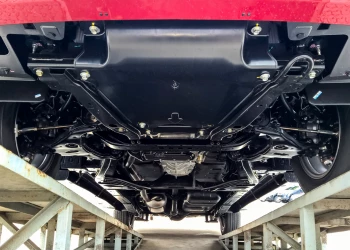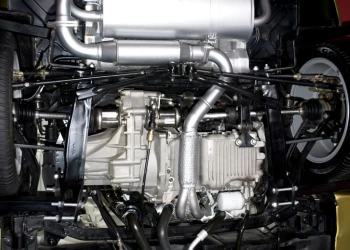Radio Frequency Identification (RFID) is coming to a tire near you
Add bookmarkRadio Frequency Identification – or RFID – facilitates production and logistics processes, delivering more transparency, fewer rejected tires and production failures, and better control of materials.
But with an ISO expected to be introduced by the end of 2019, is RFID the key to turning tires into big tech?
The next big thing
RFID is the hottest topic in the tire industry right now. A technology that originated in the 1940s and since utilized in many other industries, RFID has broken into the tire world at such speed that the ISO TC31 WG 10 working group is still working on a universal standard, the results of which are expected in December 2019.
But what is the current state of such technology, and what is the industry doing to get the most out of its benefits?
RFID has the potential to bring increased efficiencies to tire production and logistics processes – including gathering of significantly increased amounts of data.
“It will deliver more transparency, fewer rejected tires and production failures, and better control of materials,” says Jos Uijlenbroek of Ferm RFID Solutions. “During the last 10 years, RFID has emerged as the answer to the industry's problem. It is a technology which will rapidly change the tire industry by supporting improvement of the overall quality of individual tires.”
Furthermore, large amounts of data will help make better-informed decisions as RFID takes the lead in the tire industry’s push towards Industry 4.0.
How does RFID work?
The RFID system comprises a chip or tag equipped with an antenna that is applied to the tire’s rubber or any dipped-mesh material. This chip transmits its data to a handheld or stationary reader that includes a receiver. “When a tag passes the reading field of an antenna, it reads the tag and sends the unique identification number back to the system,” explains Uijlenbroek. “This can be a speedy process, with up to 300 of these identifications per second.
“In comparison to identification by barcodes there is no line-of-sight needed between the reader and the tag. Identification can occur in bulk, up to 150 tires in one scan. And the distance from which RFID tags can be read is more flexible than for barcodes, from zero up to several feet.”
The industry has acknowledged the potential benefits and is moving quickly to adopt the technology.
Fitting into the tire
The basic concept of RFID solutions is relatively simple. “The challenge for a successful implementation lies in dealing with the complex and harsh environment of tire manufacturing. A number of solutions have addressed these factors and are available in the market,” says Uijlenbroek.
“In mixing processes, RFID labels can be applied on the big bags of chemicals, rubber and an RFID reader fixed on the loader. The moment the wrong chemicals are recognized by the reader the loader will stop, and an alarm is activated. Mistakes can, therefore, be prevented before they occur.”
Likewise, in the production process, an RFID reader placed in a tire manufacturing machine, set up to produce a specific type of tire, can also prevent problems before they occur since RFID chips are also embedded into the parts and tools. “The machine will recognize if the correct tools are loaded to build the tire to specifications, and if there is no match, then the machine does not start,” says Uijlenbroek.
“In mold management, all segments, bead rings, container and molds can be fitted with an integrated RFID tag protected by the component itself. Using RFID, a parent-child relationship is created between the mold, bead rings and segments. The parent-child relation makes it easy to count the sequence of the segments within the mold.”
Further, RFID serves a support function when it comes down to the material flow within the tire building facilities. According to Rubbernews.com, placing an RFID tag on a carrier, such as a trolley, matches material with a specific carrier. Therefore, material flows will be transparent and can be recognized by the machines and easily located within the factory.
Uijlenbroek explains that the use of vulcanizable RFID tags on each tire controls the complete lifecycle of the tire from the building machine to vulcanization; to the end-user and right through to the scrapping of the used tire. RFID also can be used to support material flow within the factory.
“The use of vulcanizable RFID tags on each tire controls the complete lifecycle of the tire from building machine, vulcanization, coupling with the end-user and finally through to the scrapping of the used tire,” says Uijlenbroek.
Another benefit is that customized RFID aftermarket labels have been developed to serve further purposes, such as supporting fleet management, setting up anti-theft solutions and to develop pay-per-mile, pay-per-use or other new commercial business models. Uijlenbroek adds, “By creating a slot in a new or existing tire, even small tire companies, such as retreaders and repair shops, can offer local fleets new business models.”
Towards universal RFID
Such benefits in the manufacturing and logistics processes are of course of great value for an industry that has remained somewhat conservative, particularly regarding the use of data.
However, Uijlenbroek says that Industry 4.0, new business models, end-user data and a need for full transparency are among the triggers for taking a big leap forward, embracing new technology and developing an RFID strategy.
“As the original equipment market demands full transparency in production logistics and overall product quality, test reports and good tires at a low price are no longer enough.”
At present, for Michelin’s Industrial Standards and Government Regulations expert Pierre Loiret, the starting point to implement RFID in the whole industry is by guaranteeing the traceability of each tire with a unique identifier readable by all stakeholders.
“The key to get access to tire information is the use of an ISO-standardized Unique Item Identifier (UII), through which all the data can be accessed across the world.”
Loiret also sits on the ISO TC31 WG 10 working group, which is developing the universal ISO standard for RFID tire tags, due by the end of 2019. He adds “Some 60 experts from Austria, Belgium, China, Finland, France, Germany, Italy, Japan, Netherlands, South Korea, Thailand, the United Kingdom and the US are providing input to the working group.”
The benefits of RFID to the tire industry are clear. Right from the very beginning of the production process through to the end of each tire’s life, improved data should allow for much better traceability, few errors and better efficiency throughout. However, some obstacles remain, including the arrival of a universal ISO standard, but once in place, the industry looks set to roll on into its new, data-driven era.
- Interested in the latest trends in tire technology? Automotive IQ's Intelligent Tire Technology conference takes place in Germany from 26-28 November. Check out our Events page for the full list of upcoming conferences.






















